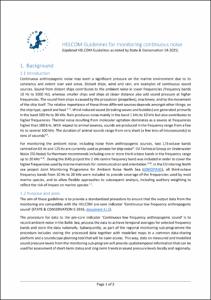| dc.coverage.spatial | Baltic Sea | en_US |
| dc.date.accessioned | 2022-07-12T21:47:05Z | |
| dc.date.available | 2022-07-12T21:47:05Z | |
| dc.date.issued | 2018 | |
| dc.identifier.citation | HELCOM (2018) HELCOM Guidelines for monitoring continuous noise. Helsinki, Finland, HELCOM, 10pp. DOI: http://dx.doi.org/10.25607/OBP-1800 | en_US |
| dc.identifier.uri | https://repository.oceanbestpractices.org/handle/11329/2005 | |
| dc.identifier.uri | http://dx.doi.org/10.25607/OBP-1800 | |
| dc.description.abstract | Continuous anthropogenic noise may exert a significant pressure on the marine environment due to its constancy and extent over vast areas. Distant ships, wind and rain, are examples of continuous sound sources. Sound from distant ships contributes to the ambient noise in lower frequencies (frequency bands 10 Hz to 1000 Hz), whereas smaller ships and ships at closer distance also add sound pressure at higher frequencies. The sound from ships is caused by the propulsion (propellers), machinery, and by the movement of the ship itself. The relative importance of these three different sources depends amongst other things; on the ship type, speed and load 1–3. Wind-induced sound (breaking waves and bubbles) are generated primarily in the band 100 Hz to 30 kHz. Rain produces noise mainly in the band 1 kHz to 10 kHz but also contributes to higher frequencies. Thermal noise resulting from molecular agitation dominates as a source at frequencies higher than 100 kHz. With respect to animal sources, sounds are produced in the frequency range from a few Hz to several 100 kHz. The duration of animal sounds range from very short (a few tens of microseconds) to tens of seconds4,5.
For monitoring the ambient noise, including noise from anthropogenic sources, two 1/3-octave bands centred on 63 Hz and 125 Hz are currently used as proxies for ship noise6. EU Technical Group on Underwater Noise (TG Noise) furthermore recommends including one or more third octave bands in the frequency range up to 20 kHz 6–8. During the BIAS project the 2 kHz centre frequency band was included in order to cover the higher frequencies used by marine mammals for communication and orientation 9,10. In the EU Interreg North sea project Joint Monitoring Programme for Ambient Noise North Sea (JOMOPANS), all third-octave frequency bands from 10 Hz to 20 kHz were included to provide coverage of the frequencies used by most marine species, and to allow flexible approaches to subsequent analysis, including auditory weighting to reflect the risk of impact on marine species 11.
1.2 Purpose and aims
The aim of these guidelines is to provide a standardized procedure to ensure that the output data from the monitoring are compatible with the HELCOM pre-core indicator ‘Continuous low frequency anthropogenic sound’ (STATE & CONSERVATION 5-2016, document 4J-2).
The procedure for data to the pre-core indicator ‘Continuous low frequency anthropogenic sound’ is to record ambient noise in the Baltic Sea, process the data to achieve temporal averages for selected frequency bands and store the data nationally. Subsequently, as part of the regional monitoring sub-programme the procedure includes storing the processed data together with modelled maps in a common data-sharing platform and a soundscape planning tool that will be open access. This way, data on measured and modelled sound pressure levels from the monitoring sub-program will provide spatiotemporal information that can be used for assessment of short-term status and long-term trends in sound pressure levels locally and regionally. | en_US |
| dc.language.iso | en | en_US |
| dc.publisher | HELCOM | en_US |
| dc.subject.other | Monitoring | en_US |
| dc.subject.other | Underwater noise | en_US |
| dc.subject.other | Anthropogenic sound | en_US |
| dc.title | HELCOM Guidelines for monitoring continuous noise. | en_US |
| dc.type | Report | en_US |
| dc.description.status | Published | en_US |
| dc.format.pages | 10pp. | en_US |
| dc.contributor.corpauthor | HELCOM | en_US |
| dc.description.refereed | Refereed | en_US |
| dc.publisher.place | Helsinki, Finland | en_US |
| dc.subject.parameterDiscipline | Acoustics | en_US |
| dc.subject.parameterDiscipline | Human activity | en_US |
| dc.description.currentstatus | Current | en_US |
| dc.description.sdg | 14.1 | en_US |
| dc.description.eov | Ocean sound | en_US |
| dc.description.maturitylevel | Mature | en_US |
| dc.description.adoption | Multi-organisational | en_US |
| dc.description.adoption | International | en_US |
| dc.description.methodologyType | Method | en_US |
| dc.description.methodologyType | Specification of criteria | en_US |
| obps.endorsementAuthorDeclared.deJureStandard | HELCOM | |
| obps.contact.contactemail | info@helcom.fi | |
| obps.resourceurl.publisher | https://helcom.fi/helcom-at-work/publications/manuals-and-guidelines/ | |
 Repository of community practices in Ocean Research, Applications and Data/Information Management
Repository of community practices in Ocean Research, Applications and Data/Information Management
